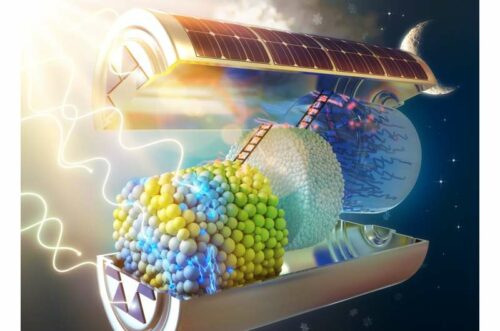Researchers have developed a new solar battery solution based on a bi-functional carbon nitride (K-PHI) photoanode that can both absorb light and store electric charge.

Scientists from around the world have been trying to improve the solar technologies and provide efficient storing and energy conversion solutions. They believe that the field of solar research is still at its infant stage and has multiple levels of integration and is very diverse in concepts and ideas.
Researchers from Max Planck Institute for Solid State Research have introduced a sustainable integrated solar battery design based on materials that are abundant on Earth. The device is based on a bi-functional carbon nitride (K-PHI) photoanode that can both absorb light and store electric charge.
Essentially, when batteries are charged using light, one of the photogenerated charge carriers needs to be transferred from a photoactive electrode to another “counter” electrode. In most previously developed solar batteries, which are based on solid electrodes, this process occurs through an external wire. But Prof. Bettina Lotsch and researcher Andreas Gouder, in their work, set out to create a battery solution in which this process occurred internally. To do this, they introduced a multifunctional separator, which separates the two electrodes inside their battery.
The design consists of two electrodes (i.e., anode and cathode), and a separator between them. The absorption of light is carried out by the anode, which is made of K-PHI. The photogenerated electrons are stored directly in the K-PHI, while photogenerated holes are transferred to the cathode, made of the organic conductive polymer PEDOT:PSS. In this device, the transfer mechanism occurs internally, which is unique and rectified and is performed by a hole transporting layer (organic conductive polymer F8BT). In principle, one can operate this device as a normal solar cell or a normal battery (when kept in the dark and charged/discharged with an applied electric current), but several light assisted modes become possible
The team evaluated their solar battery in a series of tests and found that it achieved highly promising results. Solar light can assist a solar battery’s charging or assist both charging and discharging processes. The researchers found that their solution applied to both charging and discharging processes significantly increased the extracted energy by 94.1% compared to when the battery was operated like conventional batteries, in the dark.
The integrated solar battery design proposed by this team of researchers could soon inspire other teams to create similar sustainable batteries based on carbon nitride photoanodes or utilizing separators. Meanwhile, the researchers plan to improve their technology further, to improve its energy-efficiency and facilitate its commercialization.
Reference : A. Gouder et al, An integrated solar battery based on a charge storing 2D carbon nitride, Energy & Environmental Science (2023). DOI: 10.1039/D2EE03409C






